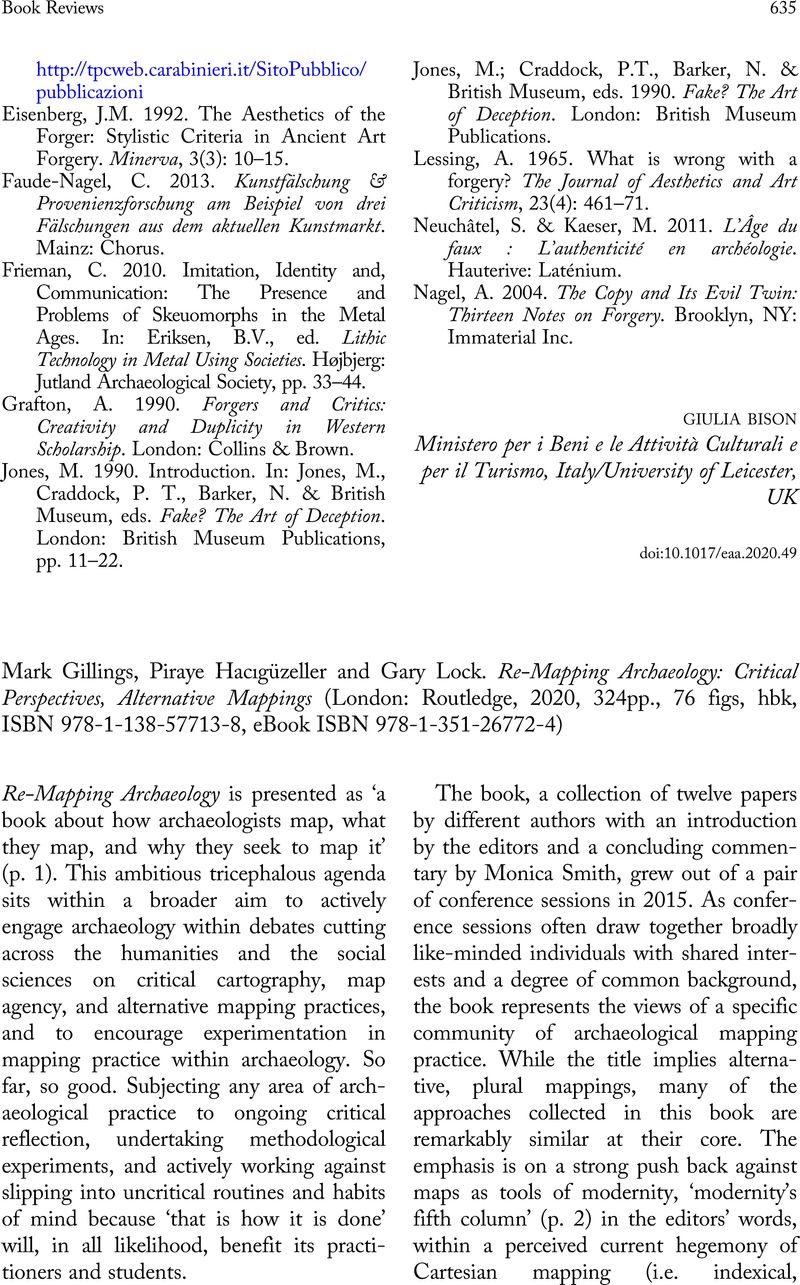No CrossRef data available.
Article contents
Mark Gillings, Piraye Hacıgüzeller and Gary Lock. Re-Mapping Archaeology: Critical Perspectives, Alternative Mappings (London: Routledge, 2020, 324pp., 76 figs, hbk, ISBN 978-1-138-57713-8, eBook ISBN 978-1-351-26772-4)
Published online by Cambridge University Press: 25 November 2020
Abstract
An abstract is not available for this content so a preview has been provided. Please use the Get access link above for information on how to access this content.

- Type
- Book Review
- Information
- Copyright
- Copyright © European Association of Archaeologists 2020
References
Abend, P., & Harvey, F. 2017. Maps as Geomedial Action Spaces: Considering the Shift from Logocentric to Egocentric Engagements. GeoJournal, 82(1): 171–83. doi: https://doi.org/10.1007/s10708-015-9673-zCrossRefGoogle Scholar
Bogucka, E.P. & Meng, L. 2019. Projecting Emotions from Artworks to Maps Using Neural Style Transfer. Proceedings of the ICA, Vol. 2. Gale Academic OneFile.CrossRefGoogle Scholar
Bostan, B., & Tingoy, O. 2016. Game Design and Gamer Psychology. In: Bostan, B., ed. Gamer Psychology and Behavior. Cham: Springer, pp. 105–21. di: https://doi.org/10.1007/978-3-319-29904-4_7Google Scholar
Cook, K. 2020. Re-coding Collaborative Archaeology: Digital Teaching and Learning for a Decolonised Future. In: Hageneuer, S., ed. Communicating the Past in the Digital Age: Proceedings of the International Conference on Digital Methods in Teaching and Learning in Archaeology (12th-13th October 2018). London: Ubiquity Press, pp.115–26. [accessed 9 July 2020]. Available at: <https://www.jstor.org/stable/j.ctv11cvx4t.14>Google Scholar
Gillings, M., Hacıgüzeller, P. & Lock, G., eds. 2020. Archaeological Spatial Analysis: A Methodological Guide. London & New York: Routledge.CrossRefGoogle Scholar
Gupta, N., & Devillers, R. 2017. Geographic Visualization in Archaeology. Journal of Archaeological Method and Theory, 24(3): 852–85. doi: https://doi.org/10.1007/s10816-016-9298-7CrossRefGoogle Scholar
Lambers, K., Verschoof-van der Vaart, W.B., & Bourgeois, Q.P. 2019. Integrating Remote Sensing, Machine Learning, and Citizen Science in Dutch Archaeological Prospection. Remote Sensing, 11(7):794. doi: https://doi.org/10.3390/rs11070794CrossRefGoogle Scholar
Petrie, C.A., Orengo, H.A., Green, A.S., Walker, J.R., Garcia, A., Conesa, F. et al. . 2019. Mapping Archaeology While Mapping an Empire: Using Historical Maps to Reconstruct Ancient Settlement Landscapes in Modern India and Pakistan. Geosciences, 9(1):11. doi: https://doi.org/10.3390/geosciences9010011Google Scholar
Richards-Rissetto, H. & Landau, K. 2019. Digitally-Mediated Practices of Geospatial Archaeological Data: Transformation, Integration, & Interpretation. Journal of Computer Applications in Archaeology, 2(1): 120–35. doi: http://doi.org/10.5334/jcaa.30CrossRefGoogle Scholar
Robinson, A.C., Demšar, U., Moore, Buckley, A., Jiang, B., Field, K., Kraak, M.-J. et al. 2017. Geospatial Big Data and Cartography: Research Challenges and Opportunities for Making Maps that Matter. International Journal of Cartography, 3(1): 32–60. doi: https://doi.org/10.1080/23729333.2016.1278151Google Scholar


